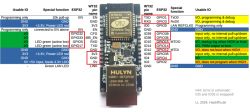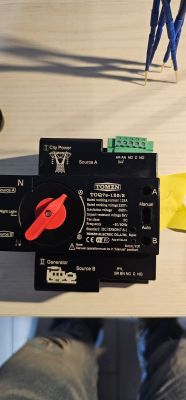FAQ
TL;DR: For web-enabled ventilation, 30 zł builds using ESP8266 + DS18B20 are proven—“You should be able to come up with 30zl.” Flash ESP Easy and expose it via a router with an external IP to read four sensors online. [Elektroda, piterek-23, post #17759273]
Why it matters: This gives DIYers and facility owners a low-cost, scalable path to monitor ventilation temperatures remotely without vendor lock-in.
Quick Facts
- DS18B20 uses a 1‑Wire bus, so multiple sensors can share one cable to a single input. [Elektroda, piterek-23, post #17759324]
- Typical DIY cost: ~30 zł with ESP8266 + DS18B20 + ESP Easy and a router with external IP. [Elektroda, piterek-23, post #17759273]
- Proven build: 8 sensors on an ESP8266 with in‑app viewing and Thingspeak graphs. [Elektroda, stefbut, post #17766009]
- Ready-made option: Sonoff device with a DS18B20 socket for plug‑in temperature sensing. [Elektroda, kood, post #17759306]
- No Wi‑Fi on-site? Satel GPRS‑A offers GSM connectivity, up to 8 sensors, app control, and alerts. [Elektroda, GrubyBat, post #17766804]
What’s the cheapest way to monitor four temperatures online?
Use an ESP8266 with DS18B20 sensors and ESP Easy firmware. Configure your router with an external IP for access. Builders report doing this for about 30 zł. It’s simple, supports multiple sensors, and is easy to expand. [Elektroda, piterek-23, post #17759273]
Can I put four DS18B20 sensors on one cable?
Yes. DS18B20 uses a 1‑Wire bus that supports many devices on one data line. As noted, “you can connect multiple temperature sensors on one cable.” The controller reads each sensor sequentially, which simplifies ventilation wiring. [Elektroda, piterek-23, post #17759324]
I’m not a programmer—are there any ready-made modules?
Yes. Sonoff devices with a DS18B20 socket let you plug in a temperature probe and manage it in their app. This is a quick path when you want minimal wiring and configuration. It suits simple temperature readouts. [Elektroda, kood, post #17759306]
Can a Sonoff read four sensors at once?
In this thread, Sonoff was noted with a single temperature input. For four measurement points, builders chose different hardware to handle multiple probes. That keeps the setup straightforward. [Elektroda, stefbut, post #17759312]
How do I see my temperatures from anywhere without port-forwarding?
Publish to a cloud dashboard like Thingspeak. A shared build shows eight sensors with in‑app viewing and online graphs. This avoids opening your router to the internet while keeping remote access. Share a link or keep the channel private. [Elektroda, stefbut, post #17766009]
I don’t have Wi‑Fi at the fan—what’s the alternative?
Use a cellular gateway such as the Satel GPRS‑A. It supports up to eight sensors, offers a mobile app, and can trigger outputs and notifications based on temperature. Add a low‑cost SIM for year‑round connectivity. [Elektroda, GrubyBat, post #17766804]
Will this work with Blynk or similar apps?
Yes. An ESP8266 with four DS18B20 sensors can send readings to Blynk for a simple mobile dashboard. It delivers quick visibility without running a full automation server. Great for remote temperature views. [Elektroda, tomjed, post #17759407]
Quick start: How do I set this up in 3 steps with ESP Easy?
- Flash ESP Easy firmware onto an ESP8266 board.
- Connect your DS18B20 sensors to the ESP8266 and add the DS18B20 device in ESP Easy.
- Configure Wi‑Fi and enable remote access via your router’s external IP.
[Elektroda, piterek-23, post #17759273]
How do I wire multiple DS18B20 sensors correctly?
Use a 1‑Wire bus: connect sensors in parallel on one data line to a single microcontroller pin. Then enumerate sensors in software by their unique addresses. This keeps ventilation runs tidy. “You can connect multiple temperature sensors on one cable.” [Elektroda, piterek-23, post #17759324]
How much did a working build cost in this thread?
A complete build was reported at 50 zł for everything. The user assembled the measuring system with low-cost parts. This shows remote temperature monitoring can be done very cheaply. [Elektroda, stefbut, post #17766984]
Can I expand beyond four sensors?
Yes. One example used eight DS18B20 sensors on an ESP8266 with an app view and Thingspeak graphs. That demonstrates the approach scales well for ventilation zones. Expansion is straightforward. [Elektroda, stefbut, post #17766009]
Do I need an external IP to reach the device directly?
For direct internet access to your ESP8266, use a router with an external IP. Without it, direct remote access will fail; use a cloud dashboard instead. This applies when exposing services online. [Elektroda, piterek-23, post #17759273]
Is there an example dashboard I can view?
Yes. See the shared Thingspeak channel for logged temperatures: https://thingspeak.com/channels/699181. It shows multi‑sensor graphs accessible from anywhere. Use it as a reference for your setup. [Elektroda, stefbut, post #17767056]
Is there a module that logs to Thingspeak out of the box?
Yes. A participant mentioned a module for four DS18B20 sensors with storage on Thingspeak. That gives ready cloud logging without extra coding. It’s handy for quick deployments. [Elektroda, Strumien swiadomosci swia, post #17766873]
I’m still unsure—can a beginner really do this?
Yes. A helper said the task is trivial if you can install software and connect wires. “If you can install the software and connect the wires to the board then you can do it.” Community help is available. [Elektroda, tomjed, post #17760373]
Are cellular solutions cost‑effective?
One builder compared a 50 zł DIY ESP8266 setup with the Satel GPRS‑A and called the latter’s price “from space.” Choose GSM when Wi‑Fi is impossible or reliability demands it. [Elektroda, stefbut, post #17766984]





